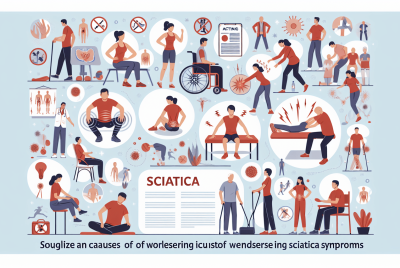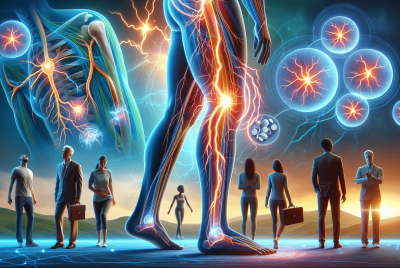What Are The Differences Between Acute And Chronic Back Pain?
Have you ever experienced back pain and wondered if it is acute or chronic? Understanding the differences between these two types of back pain is essential in obtaining the appropriate treatment and managing your symptoms effectively. acute back pain is characterized by a sudden onset and usually lasts for a short period of time, whereas chronic back pain persists for longer durations. By distinguishing between these two types, you can gain insight into the nature of your pain and make informed decisions on how to alleviate it.
Definition of Acute and Chronic Back Pain
Acute Back Pain
Acute back pain refers to a sudden, intense pain that lasts for a short duration. It usually occurs as a result of an injury or trauma to the back, such as lifting heavy objects, sudden movements, or accidents. This type of back pain typically resolves within a few weeks with appropriate treatment and rest.
Chronic Back Pain
chronic back pain, on the other hand, is characterized by persistent pain that lasts for more than three months. It may result from an underlying condition or injury, or it can develop gradually over time. Chronic back pain can significantly affect a person’s quality of life, as it tends to be long-lasting and may require ongoing management and treatment.
Causes and Triggers
Acute Back Pain Causes
The most common cause of acute back pain is muscle strain or sprain. This can occur due to lifting heavy objects, sudden twisting or bending, or engaging in strenuous physical activities without proper warm-up or conditioning. Other causes include herniated discs, spinal stenosis, fractures, and injuries to the ligaments or tendons in the back.
Chronic Back Pain Causes
Chronic back pain can have various underlying causes, including degenerative disc disease, osteoarthritis, spinal abnormalities, spinal infections, and inflammatory conditions such as ankylosing spondylitis. It can also be triggered by repetitive motions, poor posture, obesity, and psychological factors such as stress and depression.
Trigger Factors for Acute Back Pain
Acute back pain can be triggered by sudden movements, such as lifting heavy objects incorrectly or twisting the back abruptly. It can also be influenced by poor posture, prolonged sitting or standing, and overexertion during physical activities.
Trigger Factors for Chronic Back Pain
Chronic back pain can be triggered or worsened by factors such as physical or emotional stress, poor ergonomics, lack of exercise or physical activity, and certain lifestyle habits like smoking or excessive alcohol consumption. Additionally, cold weather and changes in atmospheric pressure can also exacerbate chronic back pain symptoms in some individuals.

Duration and Persistence
Duration of Acute Back Pain
Acute back pain typically lasts for a few days to a few weeks, depending on the underlying cause and the individual’s response to treatment. With appropriate rest, pain management, and therapy, most people experience significant relief within a short period.
Persistence of Chronic Back Pain
Chronic back pain, on the other hand, can persist for months or even years. It may wax and wane in intensity, but it is a constant presence in the person’s life. Managing chronic back pain requires a comprehensive and long-term treatment approach to improve symptoms and enhance the individual’s overall well-being.
Symptoms
Symptoms of Acute Back Pain
Symptoms of acute back pain usually include a sharp, localized pain in the affected area, muscle stiffness or spasms, limited range of motion, and difficulty performing daily activities. In some cases, individuals may also experience radiating pain down the legs or arms depending on the root cause of the pain.
Symptoms of Chronic Back Pain
Chronic back pain is often described as a dull, aching sensation that may be constant or intermittent. The pain can be accompanied by muscle weakness, numbness or tingling sensation in the limbs, reduced mobility, fatigue, and difficulty sleeping. The severity and frequency of symptoms can vary from person to person.

Risk Factors
Risk Factors for Acute Back Pain
Risk factors for acute back pain include poor physical conditioning, improper lifting techniques, sudden or excessive physical exertion, obesity, and a sedentary lifestyle. Additionally, occupations that involve repetitive or heavy lifting, as well as high levels of physical activity, can increase the risk of developing acute back pain.
Risk Factors for Chronic Back Pain
Individuals who have experienced acute back pain in the past are at a higher risk of developing chronic back pain. Other risk factors include advanced age, certain occupations that involve prolonged sitting or standing, previous back injuries, poor posture, and certain medical conditions such as arthritis or osteoporosis.
Underlying Conditions
Common Underlying Conditions for Acute Back Pain
Acute back pain is often caused by temporary conditions such as muscle strain, sprain, or minor injuries to the back. These conditions typically resolve with proper rest and treatment, without causing long-term implications.
Common Underlying Conditions for Chronic Back Pain
Chronic back pain can be attributed to various underlying conditions, including degenerative disc disease, bulging or herniated discs, spinal stenosis, osteoarthritis, fibromyalgia, and nerve damage. In some cases, the exact cause of chronic back pain may be challenging to determine.

Diagnosis
Diagnosing Acute Back Pain
Diagnosing acute back pain is usually based on a thorough physical examination, medical history, and a discussion of the symptoms. In some cases, imaging studies such as X-rays or MRI scans may be ordered to rule out any underlying structural abnormalities or injuries.
Diagnosing Chronic Back Pain
Diagnosing chronic back pain involves a more comprehensive evaluation, including a detailed medical history, physical examination, imaging tests, and sometimes specialized diagnostic procedures such as discography or nerve conduction studies. The goal is to identify the underlying cause and develop an appropriate treatment plan.
Treatment Approaches
Treatment Options for Acute Back Pain
The treatment of acute back pain focuses on relieving pain and inflammation, promoting healing, and preventing further injury. This typically involves a combination of pain medications, rest, hot or cold packs, physical therapy, and gentle exercises to improve strength and flexibility. In some cases, short-term bracing or immobilization may be recommended.
Treatment Options for Chronic Back Pain
Treating chronic back pain requires a multidisciplinary approach tailored to the individual’s specific needs. This may include a combination of pain medications, physical therapy, chiropractic care, acupuncture, psychological counseling, and in some cases, minimally invasive procedures or surgery. The goal is to manage pain, improve functionality, and enhance the person’s overall quality of life.
Differences in Medication Usage
For acute back pain, over-the-counter pain relievers such as nonsteroidal anti-inflammatory drugs (NSAIDs) are often sufficient to manage pain and reduce inflammation. In the case of chronic back pain, stronger pain medications such as opioids may be prescribed temporarily, but they are typically used cautiously and as a last resort due to their potential for dependence and side effects.
Therapy and Rehabilitation for Acute Back Pain
Physical therapy and rehabilitation play a crucial role in the treatment of acute back pain. These interventions focus on restoring mobility, promoting healing, and preventing future injuries. Therapies such as stretching, strengthening exercises, massage, and heat therapy are commonly used to alleviate pain and improve function.
Therapy and Rehabilitation for Chronic Back Pain
In the case of chronic back pain, therapy and rehabilitation are long-term components of the treatment plan. Physical therapy aims to improve flexibility, strength, and posture, while occupational therapy helps individuals adapt their daily activities to reduce pain and maximize function. Additionally, specialized pain management programs and psychological counseling can help address the emotional and psychological impact of living with chronic pain.
Prognosis and Outlook
Prognosis of Acute Back Pain
The prognosis for acute back pain is generally favorable. With appropriate treatment and rest, most individuals experience significant relief within a few weeks and return to their normal activities without long-term complications.
Prognosis of Chronic Back Pain
The prognosis for chronic back pain varies depending on the underlying cause, individual factors, and the effectiveness of treatment. While some individuals may find relief and manage their symptoms effectively, others may continue to experience chronic pain despite various interventions. However, with proper management and lifestyle modifications, many individuals with chronic back pain are able to lead fulfilling lives and minimize the impact on their daily activities.
Preventive Measures
Preventing Acute Back Pain
To prevent acute back pain, it is important to maintain a healthy lifestyle, including regular exercise, proper posture, and weight management. It is also essential to use proper lifting techniques, avoid sudden or excessive physical exertion, and take breaks during prolonged sitting or standing. Additionally, using ergonomic furniture and practicing stress management techniques can contribute to preventing acute back pain.
Preventing Chronic Back Pain
Prevention of chronic back pain involves adopting and maintaining healthy lifestyle habits. This includes regular exercise to strengthen the back and core muscles, maintaining a healthy weight, practicing good posture, and engaging in activities that promote flexibility. Avoiding smoking and excessive alcohol consumption, managing stress levels, and practicing safe lifting techniques can also help reduce the risk of developing chronic back pain.
In conclusion, understanding the differences between acute and chronic back pain is crucial in managing and treating these conditions effectively. By recognizing the causes, symptoms, risk factors, and treatment options associated with each, individuals can take proactive measures to prevent back pain and seek appropriate care when needed. Remember to consult with a healthcare professional before initiating any treatment plan or making significant lifestyle changes. With the right approach, back pain can be managed, allowing you to enjoy a healthy, pain-free life.




